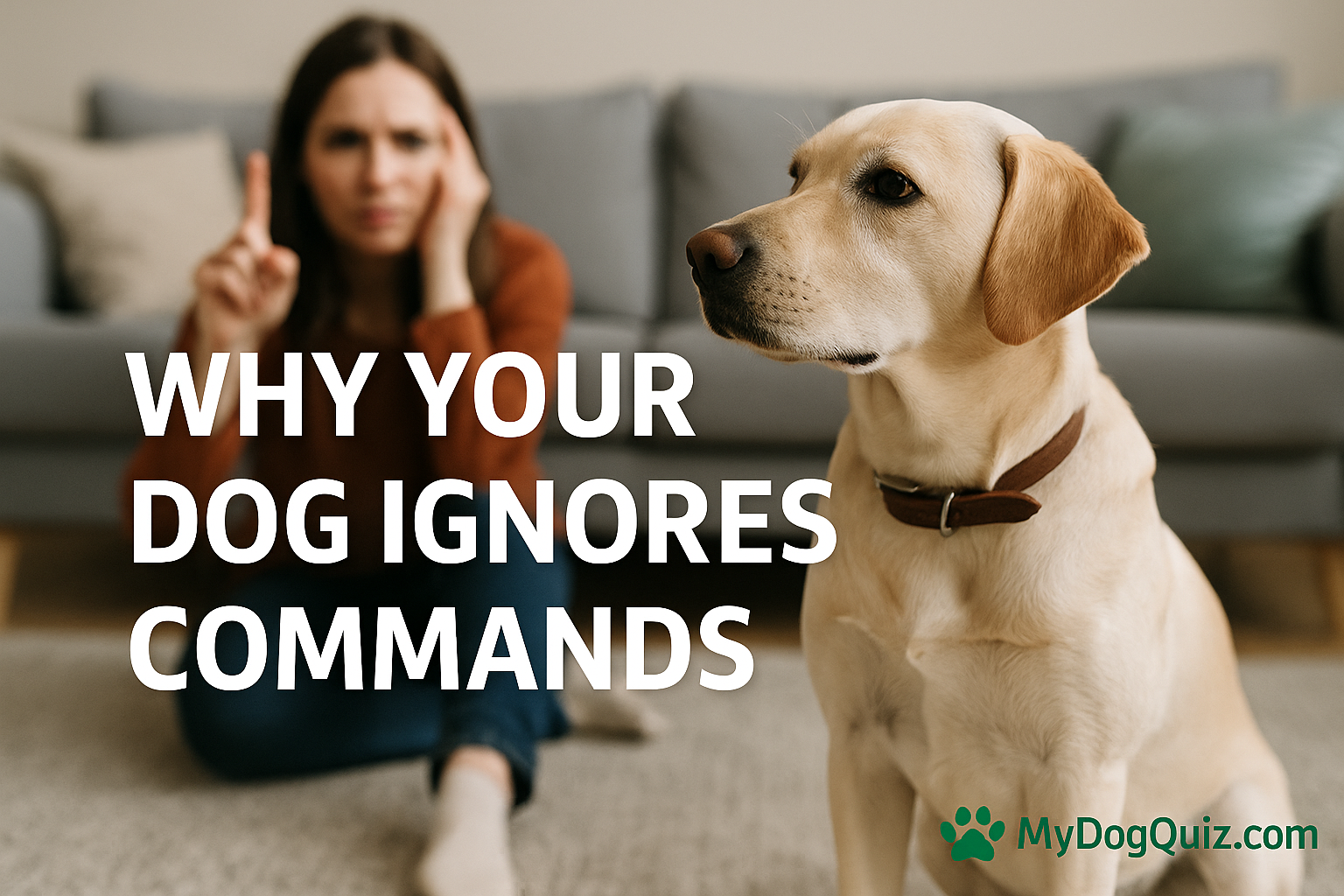You tell your dog to sit.
They look at you.
Then they turn around and sniff the floor.
It’s frustrating — and maybe even a little embarrassing when it happens in public. You’ve repeated the command a hundred times. You’ve offered treats, praise, even stern looks.
So why does your dog act like they’ve never heard you before?
As it turns out, there’s real science behind your dog’s “selective hearing” — and once you understand it, you’ll see obedience in a whole new light.
👉 Take the 30-Second Dog Brain Quiz to discover how your dog’s brain learns and what type of training actually works for them.
1. Your Dog’s Brain Doesn’t Process Words the Way You Think
Dogs can learn hundreds of words — but they don’t interpret them like humans do.
When you say “sit,” your dog doesn’t hear the meaning of the word. They recognize a pattern of sounds linked to a movement and a result (like a treat).
Here’s the problem: if your tone, posture, or environment change, your dog’s brain doesn’t make the same connection. To them, “sit” in the kitchen might not equal “sit” in the park.
Their brain treats it like two different commands.
That’s why dogs often “forget” what they’ve learned outside of the house.
Their training isn’t generalizing — it’s environment-specific.
👉 Tip: When practicing commands, vary your location, posture, and tone. You’re teaching your dog to associate the action, not just the sound.
2. Repetition Without Reward Turns into Background Noise
You’ve probably said “come here” more times than you can count.
But if your dog doesn’t respond quickly and you keep repeating it, something subtle happens in their brain — habituation.
It’s the same phenomenon that lets you tune out a ticking clock or traffic noise.
When a sound repeats with no meaningful outcome, the brain starts ignoring it.
So when you call “come here!” and your dog doesn’t get a reason to care — food, praise, or excitement — they mentally file that sound under “unimportant.”
In other words, you accidentally trained them not to listen.
👉 Fix: Make your commands predict success.
Call once, reward big when they respond, and stop repeating words that don’t lead to positive reinforcement.
3. Emotion Overrides Logic
Think about how hard it is to focus when you’re angry or nervous.
Dogs feel the same way.
When they’re excited, scared, or overstimulated, the amygdala (the emotional center of their brain) takes over — blocking access to the frontal cortex, where learning and decision-making happen.
That’s why even a well-trained dog “forgets” everything the moment a squirrel runs by.
It’s not disobedience. It’s biology.
The solution? Calm the brain first, train second.
Brain-based games (like those found in Brain Training for Dogs) are designed to build impulse control and focus — making it easier for your dog to think clearly even under excitement or stress.
4. Your Dog Might Be Guessing What You Mean
Dogs are expert readers of body language, not vocabulary.
In fact, they pay attention to your movement and tone more than your words.
If your gestures or expressions change between sessions, your dog’s brain gets conflicting data.
Say you teach “down” with a hand motion pointing to the floor. Later, you say “down” while standing straight — your dog might not recognize it as the same command.
They’re not being stubborn; they’re just confused by mixed signals.
👉 Fix: Be consistent. Use the same tone, gestures, and timing for every command. When you need to change something, retrain it like a new skill.
5. Dogs Learn Best Through Problem Solving
The most effective learning happens when your dog’s brain is actively engaged, not just following orders.
Dogs who think, explore, and experiment form stronger neural pathways — the same kind humans use for creative thinking.
When training becomes a guessing game they can win (like sniffing out a treat under a cup or solving a mini-puzzle), your dog’s motivation skyrockets.
That’s what the Brain Training for Dogs approach is all about — turning obedience into a mental game rather than a mechanical routine.
It activates your dog’s prefrontal cortex, improving focus, patience, and response speed.
👉 Curious which type of thinker your dog is?
Take the 30-Second Dog Brain Quiz and see what games match their learning style.
6. You’re Competing With the World Around Them
The modern world is full of distractions — smells, noises, people, food, and other dogs.
When your dog doesn’t respond to commands outside, it’s not because they’re ignoring you; it’s because their sensory system is overloaded.
Dogs rely on scent and sound far more than sight, and those senses are constantly bombarded with new stimuli.
Each new smell or sound triggers their brain’s curiosity loop — a neurological response that prioritizes novelty over familiarity.
That means your voice might get drowned out by everything else.
Fix: Build up distractions slowly.
Train in quiet environments first, then add mild distractions (music, other people, toys) until your dog can focus anywhere.
It’s not about louder commands — it’s about stronger neural habits.
7. Your Dog Needs Mental Rehearsal, Not More Commands
Just like athletes visualize before performing, dogs benefit from structured “mental rehearsal.”
In Brain Training for Dogs, this is done through quick games that build decision-making muscles — like “The Treasure Hunt” or “The Look Game.”
Instead of endlessly repeating “stay,” you teach your dog how to choose to stay — because their brain is wired to anticipate rewards for focus.
The more choices they make correctly, the faster they learn.
It’s behavior powered by positive cognition, not obedience through repetition.
8. Training Without Understanding the Brain = Frustration
Most training advice stops at “say it louder” or “use better treats.”
But obedience isn’t about treats — it’s about neural engagement.
That’s why some dogs plateau after early success. You’ve trained the body, not the brain.
Once the brain gets bored, motivation disappears.
Brain-focused training solves that by treating each session like a puzzle.
Every solved challenge releases dopamine — the brain’s reward chemical — making learning addictive for your dog.
👉 Want to see how your dog’s brain works?
Take the 30-Second Dog Brain Quiz and find out their unique learning type.
9. When You Speak Their Brain’s Language, They Finally Listen
Dogs don’t ignore you to be defiant.
They just don’t process commands the way humans expect.
But when you understand how their brain learns — through consistency, emotion, and curiosity — obedience becomes natural.
Your dog wants to please you. They just need the right kind of stimulation to understand you.
Start small.
Play brain games.
Make learning fun.
And soon, that blank stare when you say “sit” will turn into focus — and a wagging tail.
🦴 Final Call to Action
Your dog isn’t stubborn.
They’re smart — maybe too smart for outdated training methods.
Once you unlock how their mind works, you’ll never have to shout, repeat, or beg again.
👉 Take the 30-Second Dog Brain Quiz
Discover your dog’s learning personality and get personalized tips on how to make them listen — happily, every time.
Because the science of training isn’t about dominance…
It’s about understanding the brain you’re talking to.


Leave a Reply